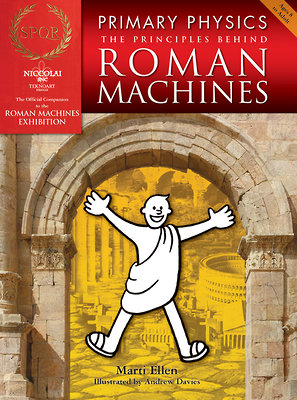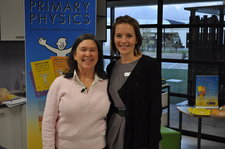“Primary Physics” is a Force to be Reckoned With
Physics is one of the oldest academic fields of study and deals with discovering the rules which all physical objects — little ones, big ones, light ones and heavy ones — obey. It’s a general analysis of nature conducted to understand how the universe behaves. Holding, moving, dropping and rolling all demonstrate physics. Attention-grabbing retailers might set up a demonstration of some of these actions to entice customers to ask questions. This leads into showing them Primary Physics: The Principles Behind Roman Machines, a fascinating book that teaches kids about eight different models of inventions from the time of the Roman Empire. This amazing book, that engages both boys and girls, takes a heavy subject and handles it lightly. It does more than simply discuss the inventions: it shows in detail how to make each one, using common household items including Popsicle sticks, modeling clay and other inexpensive materials. In addition to the easy-to-follow instructions, each section includes basic physics lessons that relate to the model.
Among the inventions the book explains are an abacus, battering ram, Roman arch and a pulley. Young readers not only come to understand how each machine works, but also why these inventions were so important to the Roman Empire. For example, the section on constructing a battering ram offers supporting lessons on energy, gravity, and the pendulum. In addition, many of the lessons ask readers to imagine that they are the great architect and military engineer Vitruvius, advising an army about the use of military inventions.
The 64-page book is packed with illustrations, instructional diagrams and photos. The illustrations are the work of Andrew Davies, who has also provided the artwork for previous books in this award-winning series.
Primary Physics: The Principles Behind Roman Machines has received the Fall 2012 U.S. Pinnacle Book Achievement Award in the education category, attesting to its creative concept and achievement. Scholars have praised the accuracy of its science while parents have written testimonials stressing how their child — some as young as six ––became captivated.
Marti Ellen, originally a marine biologist from the U.S. who has taught physics to young children since 1985, wrote the book. Marti immigrated to Australia and subsequently taught the Primary Physics program in several primary schools in New South Wales. Her first four books dealt with physics, energy, mass and force, simple machines and motion. She developed Primary Physics: The Principles Behind Roman Machines to accompany the Niccolai Teknoart SNC (Firenze) Roman Machines Exhibition in Melbourne that is now traveling internationally.In addition to physics, the book provides insights into history, model-making, art, mathematics, the scientific method and how to follow a procedure, all entertaining and useful skills. As Marti says, “Physics is actually very simple if you just stick to showing what is going on, step-by-step. That’s the secret to the simplicity and clarity of Primary Physics — little by little and hands-on.”
Marti Ellen is currently developing The Principles Behind Renewables, which will come with an accompanying documentary DVD.
Discover more at www.primaryphysics.com












